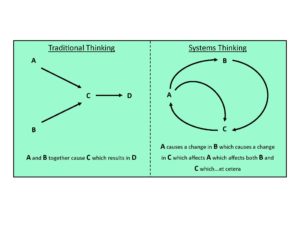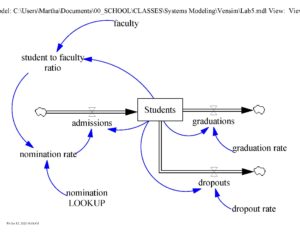By Martha McAlister
Earlier this summer, Strong Coasts Fellows completed a six-week course taught by Faculty Advisor and grant co-PI, Dr. Qiong Zhang. The course, Complex Systems Modeling, challenged us to approach some familiar problems from a non-traditional perspective, systems thinking. For example, during a timely unit on epidemic modeling, we studied COVID-19 transmission in Florida. Where a traditional mode of reasoning might lead us to evaluate the effects of individual policies or behaviors (like “safer-at-home” orders and voluntary contact avoidance) in isolation and then conclude that the end result is a sum of those individual effects, systems thinking and modeling enables us to analyze multiple factors as an integrated whole. In short, the former way of thinking is linear and reductionist through its focus on events, whereas the latter is a holistic view accounting for dynamic feedback.

With our expanded systems lens, we studied the modeling process. This was practiced through ten “lab” assignments and one group project, which were largely completed with the aid of two software programs, Python (for mathematical, network, and agent-based modeling) and Vensim PLE (for stock-and-flow modeling). The process was broken down into five steps:
- Problem articulation
- Formulation of a dynamic hypothesis
- Formation of a simulation model
- Testing
- Policy design and evaluation
Importantly, we were taught to recognize modeling as an iterative process. So, while the steps above are listed in sequential order, you can return to any previous step from any later one at any time. This is often required when, through the modeling process, you learn that your initial hypothesis (or even your initial understanding of the problem) was flawed in some way. For example, in our group project, my team hypothesized that state and federal funding was not being allocated in an effective manner to minimize the number of community water systems in California violating the maximum contaminant level for arsenic. Our initial testing (Step 4) was focused on understanding the sensitivity of the model to different levels or re-allocations of funding for arsenic compliance projects. However, we began to see realistic results (that matched available data) only when we shifted our focus to the different time elements in the system. This led to the addition of several variables in our model (back to Steps 2 and 3) that controlled the timing and duration of other system components. It turns out that, according to Donella H. Meadows, author of Thinking in Systems: A Primer, ubiquitous time delays often surprise us as we begin to understand systems. In this and in other ways, systems thinking can disillusion us to the fallacies of our own mental models. As a result, the process can lead to more unsolved problems, more unproven theories, and more questions than answers. In essence, more learning!

The group projects gave us an opportunity to practice the modeling process on a real, complex problem, relevant to our research as civil, environmental, and water resources engineering students. Project topics included: arsenic violations in California community water systems, stormwater baffle box maintenance in Tampa, FL, wastewater recovery system adoption in St. Thomas, USVI, seaweed farming practices in Belize, and curing temperature distributions in vertical concrete shafts. Each group was challenged to represent a complex system in a model that was simple, valid, and robust: simple* in that it included only those components and connections that aided in our understanding of a particular problem, valid in that its predictions were aligned with reality, and robust in that it held up to various, stated assumptions.
*Simplicity in a model could also refer to guidelines such as Andrew Ford’s (in Modeling the Environment) “Friendly Algebra Pledge.” According to Ford, complicated algebraic expressions can impede understanding, especially when the model is used as communication tool with stakeholders, or better yet, when stakeholders are involved in the process of creating the model.
References:
Meadows, D. H. Thinking in Systems: A Primer; Wright, D., Ed.; Chelsea Green Publishing: White River Junction, VT, 2008.
Ford, A. Modeling the Environment, 2nd ed.; Island Press: Washington, DC, 2010.
About the Author. Martha McAlister is pursuing a PhD in Environmental Engineering at the University of South Florida. Originally from Northeast Oregon, Martha graduated with a bachelor’s degree in 2015 from Oregon State University where she studied Civil Engineering. Martha joined the Peace Corps in 2016, serving as a Community Health Facilitator and WASH Specialist in Vanuatu, a South Pacific island nation. After returning from Vanuatu, she worked at an engineering consulting firm in Northwest Washington, where she designed community drinking water and stormwater drainage systems. She returned to school to learn more about the role of civil and environmental engineers in promoting healthy communities around the world, and more specifically, their role in advocating for and supporting those populations which are most vulnerable to environmental health risks. Martha’s current research interests lie in the application of system dynamics to complex environmental health problems.
STRONG COASTS is supported by a National Science Foundation Collaborative Research Traineeship (NRT) award (#1735320) led by the University of South Florida (USF) and the University of the Virgin Islands (UVI) to develop a community-engaged training and research program in systems thinking to better manage complex and interconnected food, energy, and water systems in coastal locations. The views expressed here do not reflect the views of the National Science Foundation.

Comments are closed.